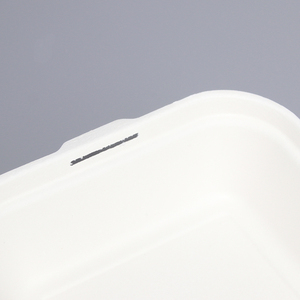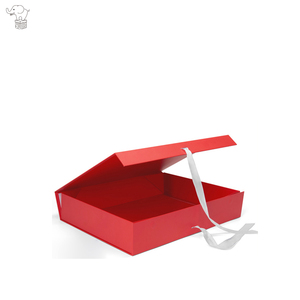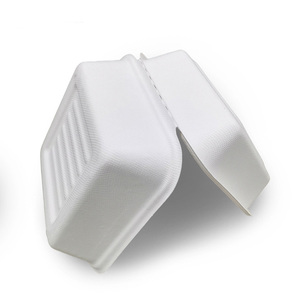(284 products available)






































































































































































































































The rise of eco-friendly packaging can be attributed to the increased demand for sustainable food packaging solutions. Composable food boxes are one of the products that gained popularity in this category. Below are some of the types of compostable food containers on the market:
Plant-based food boxes:
These food boxes are made from plants and not from oil. They use plants like sugarcane and corn. These boxes are better for the Earth because they come from plants and not from oil, which is not good for the Earth. They are good for the Earth because they are made from plants, not oil, so they break down faster and do not harm the Earth.
Paper food boxes:
Paper food boxes are also a great sustainable packaging option for businesses. Most paper or food boxes can be recycled and made into new products. When it comes to sustainability, paper food boxes have a huge advantage over plastic packaging. Even though both boxes are compostable, paper ones are easier to throw away without harming the environment. Plus, they are usually less expensive.
Mushroom food boxes:
Food boxes made from mushrooms are one of the latest inventions in sustainable packaging. These boxes are created from mycelium, the root structure of mushrooms. They provide a natural and biodegradable alternative to conventional packaging materials. Mushroom food boxes can break down in compost in a few weeks, making them an excellent choice for businesses aiming to reduce their environmental impact.
Wooden food boxes:
Food boxes made from wood are a good option for people who want to help the environment. These boxes are made by carefully cutting and putting together strips or pieces of wood. They are strong and can be used many times because they last a long time. Wooden food boxes are suitable for the Earth because, if not used anymore, they can be burned safely or turned back into wood.
Bamboo food boxes:
Bamboo food boxes are a popular choice in the sustainable packaging market. These boxes are made from bamboo, one of the fastest-growing plants in the world. Bamboo food boxes have a natural look and are strong and water-resistant. They are also easily available, so many people choose them over other boxes.
Glass food boxes:
Glass food boxes are a great alternative to disposable containers. They are made from glass, a material that can be recycled multiple times without losing its quality. This makes glass food boxes a sustainable choice for long-term use. Moreover, glass food boxes are free from harmful chemicals like BPA, ensuring the safety of the stored food. They are also easy to clean and maintain, making them a convenient option for households and businesses.
The design of composable food boxes focuses on sustainability, functionality, and aesthetics. They are created with eco-friendly materials. Such materials include paper, molded pulp, and bioplastics, which can break down naturally and not harm the environment. These food boxes are often made to have multiple uses. They can come with features like easy-to-open and reseal lids and interlocking parts for secure storage and transportation. Additionally, they may have a modular design, allowing different components to be combined or separated as required.
Materials
They are produced using biodegradable materials that can decompose naturally. For instance, they use paper, molded pulp, or bioplastics sourced from plants.
Modularity
Food boxes are composed, meaning they can be taken apart and put back together. This trait allows different parts or containers to be separated or combined as needed, making them more practical for packaging and storing food.
Interlocking parts
To keep food safe during transport and storage, these boxes have interlocking parts that fit together securely.
Easy opening and resealing
They may have features like tabs or tear notches for convenience. Resealable features allow consumers to open and close the package multiple times while keeping the contents fresh.
Aesthetic appeal
Moreover, composable food boxes are designed attractively to catch consumers' attention. They accomplish this through vibrant colors, eye-catching graphics, and clear labeling to convey the brand and product information effectively.
Composable food packaging has emerged as a solution to the plastic pollution crisis. These packages are designed to be easily disassembled, allowing different components to be recycled, composted, or disposed of separately. They offer a sustainable alternative to conventional packaging by minimizing waste and promoting circular economy practices. Here are some of the scenarios where the food packaging boxes can be used:
Takeaway food boxes
Food packaging boxes are increasingly used for takeaway foods by restaurants and cafes. These boxes offer convenience to customers as they can easily carry their meals. Moreover, with the rising trend of eco-friendliness among consumers, businesses are adopting disposable food containers that are recyclable or compostable to minimize their impact on the environment. These bio compostable food packaging supplies are designed to break down naturally in composting facilities, reducing landfill waste and the ecological footprint of food packaging.
Meal kits
Meal kits have become popular among busy individuals who want to cook at home without the hassle of grocery shopping. These kits usually come with all the ingredients pre-portioned and packaged in composable food boxes, making cooking convenient and reducing food waste. Whether it's a box from Blue Apron or Hello Fresh, users can expect to find everything they need inside, including recipe cards, to enjoy a home-cooked meal in no time.
Fresh produce packaging
Gone are the days when people shunned packaged fruits and vegetables. Nowadays, many consumers prefer composable packaging when buying fresh produce. Food manufacturers respond to this demand by using packaging that provides convenience, protects products, and minimizes environmental impact. For instance, compostable packaging for fresh produce can reduce plastic pollution and appeal to environmentally conscious shoppers. Such packaging is designed to break down naturally in composting facilities, reducing landfill waste and the ecological footprint of food packaging.
Pharmaceutical packaging
Food packaging boxes are also used in the pharmaceutical industry to deliver drugs and supplements. These boxes provide tamper-proof and airtight packaging, ensuring the safety and efficacy of the medications. With the rise of online pharmacy services, the demand for composable food boxes in the pharmaceutical sector is expected to grow further.
Wholesale buyers should seek boxes that can be easily changed to store different kinds of foods. This means that a single box design can be used for various foods, making it more versatile for storing and transporting food. Also, opt for food boxes that are simple to open and close. Food vendors and restaurants want packaging that is easy to use for themselves and their customers. Additionally, choose food boxes made from materials that can break down naturally. Look for brands that prioritize sustainability by using compostable materials like sugarcane fiber or bamboo.
Furthermore, while some compostable packaging is transparent, others have windows, and some are completely opaque. Choose the right compostable food packaging boxes that match the brand's aesthetic and marketing goals. Also, consider whether the food boxes can be branded or customized. Some brands print their logo on the boxes or use stickers and labels to do so. Lastly, think about the costs involved in making the compostable food boxes. Remember, the goal is to find affordable packaging that offers good value for the money spent.
Q1: What is a composable food box?
A1: A composable food box is packaging designed to hold food that can be broken down and recycled or biodegraded in an environmentally-friendly way.
Q2: What materials are composable food boxes made of?
A2: They are often made from biodegradable substances like plant fibers, mushrooms, and paper that can decompose naturally.
Q3: Why are composable food boxes important?
A3: They help reduce trash, lessen pollution, and promote greener ways of handling food packaging.
Q4: How do these boxes break down?
A4: Composable food boxes can decompose through natural processes like fungi action in a composting facility or exposure to microorganisms in soil.
Q5: Can they be recycled?
A5: Yes, many composable food boxes can also go through recycling processes depending on their material make-up.